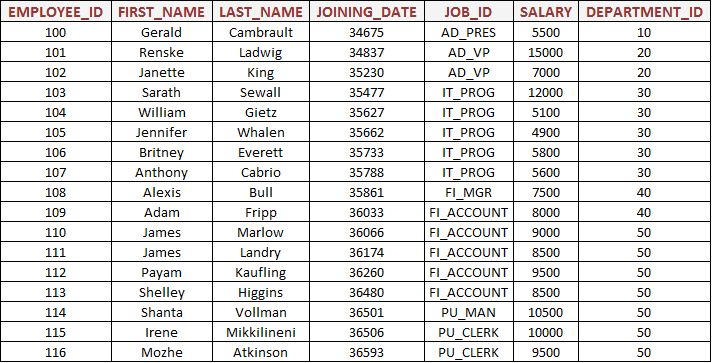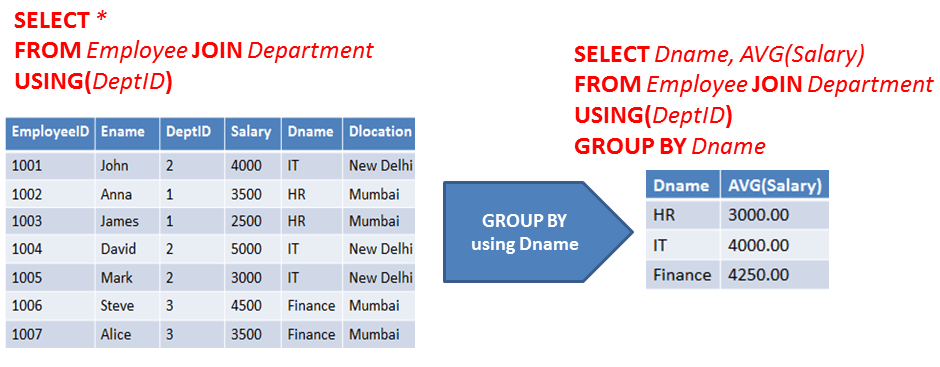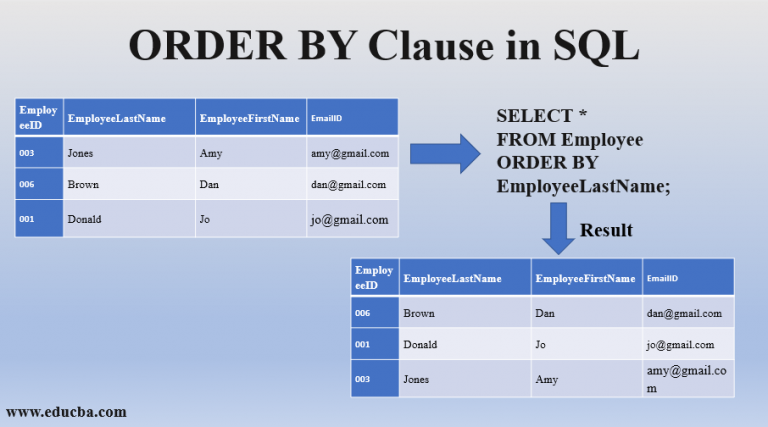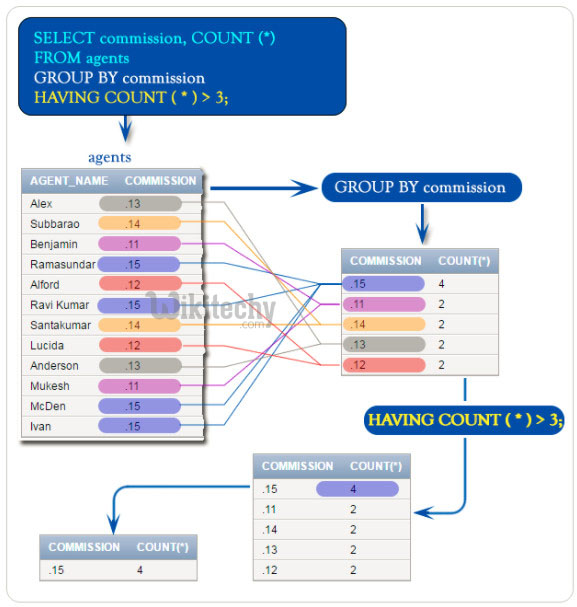Expression_n Expressions that are not encapsulated within an aggregate function and must be included in the GROUP BY Clause near the end of the SQL statement. Aggregate_function This is an aggregate function such as the SUM, COUNT, MIN, MAX, or AVG functions. Aggregate_expression This is the column or expression that the aggregate_function will be used on. HAVING condition This is a further condition applied only to the aggregated results to restrict the groups of returned rows. Only those groups whose condition evaluates to TRUE will be included in the result set. In other words, WHERE can be used to filter on table columns while HAVING can be used to filter on aggregate functions like count, sum, avg, min, and max.
The GROUP BY Clause is used together with the SQL SELECT statement. The SELECT statement used in the GROUP BY clause can only be used contain column names, aggregate functions, constants and expressions. The HAVING clause is used to restrict the results returned by the GROUP BY clause.
The GROUP BY Clause is utilized in SQL with the SELECT statement to organize similar data into groups. It combines the multiple records in single or more columns using some functions. Generally, these functions are aggregate functions such as min(),max(),avg(), count(), and sum() to combine into single or multiple columns. A query can contain both a WHERE clause and a HAVING clause.
The HAVING clause is then applied to the rows in the result set. Only the groups that meet the HAVING conditions appear in the query output. You can apply a HAVING clause only to columns that also appear in the GROUP BY clause or in an aggregate function. The SQL GROUP BY Statement The GROUP BY statement groups rows that have the same values into summary rows, like "find the number of customers in each country".
The GROUP BY statement is often used with aggregate functions ( COUNT() , MAX() , MIN() , SUM() , AVG() ) to group the result-set by one or more columns. The GROUP BY Clause is used to group rows with same values . Using the GROUP BY ClauseThe GROUP BY clause divides a table into sets. This clause is most often combined with aggregate functions that produce summary values for each of those sets. Some examples in Chapter 2 show the use of aggregate functions applied to a whole table. This chapter illustrates aggregate functions applied to groups of rows.
Thus, in the example above, we see that the table is first to split into three groups based on the column Col_A. The aggregate function to calculate the average of Col_B values is then applied to the groups. The rows are then combined and filtered based on the condition in the HAVING clause. The GROUP BY clause is a SQL command that is used to group rows that have the same values. Optionally it is used in conjunction with aggregate functions to produce summary reports from the database.
Aggregates applied to all the qualifying rows in a table are called scalar aggregates. An aggregate function in the select list with no group by clause applies to the whole table; it is one example of a scalar aggregate. The Group by clause is often used to arrange identical duplicate data into groups with a select statement to group the result-set by one or more columns. This clause works with the select specific list of items, and we can use HAVING, and ORDER BY clauses. Group by clause always works with an aggregate function like MAX, MIN, SUM, AVG, COUNT. The HAVING clause is used instead of WHERE with aggregate functions.
While the GROUP BY Clause groups rows that have the same values into summary rows. The having clause is used with the where clause in order to find rows with certain conditions. The reason is that a SELECT statement with a GROUP BY clause must return only one row per group. Columns that are listed after GROUP BY are certain to reflect only one distinct value within a group, and that value can be returned.
However, a column not listed after GROUP BY might contain different values in the rows that are contained in a group. Having Clause is basically like the aggregate function with the GROUP BY clause. The GROUP BY clause groups together the data that match a certain criterion. The apply phase applies some aggregate functions on the groups of data.
The combined phase produces a single result by combining the groups with the aggregate function result. 'Having' clause in SQL is used for aggregation operations along with 'Where', 'group by' & 'order by' condition statements. It is applied on a table/ database where there is a need for filtering aggregate results and allows 'group by' and 'order by' conditions. When the 'having' clause is used in a query, it is expected that the resulting output data set can have more than one record from the table/ database. An ORDER BY clause in SQL specifies that a SQL SELECT statement returns a result set with the rows being sorted by the values of one or more columns. The sort criteria do not have to be included in the result set.
We cannot use the HAVING clause without SELECT statement whereas the WHERE clause can be used with SELECT, UPDATE, DELETE, etc. WE can use aggregate functions like sum, min, max, avg, etc with the HAVING clause but they can never be used with WHERE clause. HAVING and WHERE are often confused by beginners, but they serve different purposes.
WHERE is taken into account at an earlier stage of a query execution, filtering the rows read from the tables. If a query contains GROUP BY, rows from the tables are grouped and aggregated. After the aggregating operation, HAVING is applied, filtering out the rows that don't match the specified conditions. Therefore, WHERE applies to data read from tables, and HAVING should only apply to aggregated data, which isn't known in the initial stage of a query. Group By clause is used for grouping the records of the database table.This clause creates a single row for each group and this process is called aggregation. To use group by clause we have to use at least one aggregate function in Select statement.
In the Group BY clause, the SELECT statement can use constants, aggregate functions, expressions, and column names. The GROUP BY Clause SQL is used to group rows with same values. SQL Having Clause is used to restrict the results returned by the GROUP BY clause.
MYSQL GROUP BY Clause is used to collect data from multiple records and returned record set by one or more columns. In the HAVING clause, you can put logical conditions involving columns and aggregate functions. All the valid elements in the SELECT list, can be involved in the HAVING clause. The GROUP BY clause causes the rows of the items table to be collected into groups, each group composed of rows that have identical order_num values .
After you form the groups, the aggregate functions COUNT and SUM are applied within each group. The GROUP BY clause combines similar rows, producing a single result row for each group of rows that have the same values for each column listed in the select list. The HAVING clause sets conditions on those groups after you form them. You can use a GROUP BY clause without a HAVING clause, or a HAVING clause without a GROUP BY clause. The HAVING clause in a SELECT specifies a condition to apply within a group or aggregate.
In other words, HAVING filters rows after the aggregation of the GROUP BY clause has been applied. Since HAVING is evaluated after GROUP BY, it can only reference expressions constructed from grouping keys, aggregate expressions, and constants. Results from a HAVING clause represent groupings or aggregations of original rows, whereas results from a WHERE clause are individual original rows. Essentially, we would be commanding the engine to not read the row since it did not pass the avg() criteria in the WHERE clause.
But hey, to determine whether it passed or failed the avg() calculation criteria, the row needs to be read into the memory. This syntax allows users to perform analysis that requires aggregation on multiple sets of columns in a single query. Complex grouping operations do not support grouping on expressions composed of input columns.
UNION in SQL is used to combine the result-set of two or more SELECT statements. The data combined using UNION statement is into results into new distinct rows. JOIN combines data from many tables based on a matched condition between them. Using the HAVING ClauseTo complement a GROUP BY clause, use a HAVING clause to apply one or more qualifying conditions to groups after they are formed.
The effect of the HAVING clause on groups is similar to the way the WHERE clause qualifies individual rows. The HAVING condition can only include columns that are used with the GROUP BY clause. To use other columns in the HAVING condition, use the aggregate functions with them. The HAVING clause includes one or more conditions that should be TRUE for groups of records. The only difference is that the WHERE clause cannot be used with aggregate functions, whereas the HAVING clause can use aggregate functions.
Note – There is a restriction regarding the use of columns in the GROUP BY clause. Each column appearing in the SELECT list of the query must also appear in the GROUP BY clause. This restriction does not apply to constants and to columns that are part of an aggregate function. The GROUP BY statement groups rows that have the same values. This statement is often used with some aggregate function like SUM, AVG, COUNT atc.
On the contrary, the HAVING clause comes into the picture only after the rows have been loaded into the memory. Once loaded into the memory, the aggregate functions perform their task on the rows HAVING the desired condition. Grouping is one of the most important tasks that you have to deal with while working with the databases. The GROUP BY clause is an optional clause of the SELECT statement that combines rows into groups based on matching values in specified columns. A HAVING clause in SQL specifies that an SQL SELECT statement must only return rows where aggregate values meet the specified conditions.
To view the present condition formed by the GROUP BY clause, the HAVING clause is used. It groups the databases on the basis of one or more column and aggregates the results. After Grouping the data, you can filter the grouped record using HAVING Clause. HAVING Clause returns the grouped records which match the given condition. The GROUP BY clause collects the rows into sets so that each row in each set has equal customer numbers. With no other columns selected, the result is a list of the unique customer_num values.
Aggregates applied to a group of rows in a specified column or expression are called vector aggregates. For either aggregate type, the results of the aggregate operations are shown as new columns that the having clause can refer to. A HAVING clause restricts the results of a GROUP BY in a SelectExpression. The HAVING clause is applied to each group of the grouped table, much as a WHERE clause is applied to a select list. If there is no GROUP BY clause, the HAVING clause is applied to the entire result as a single group.
The SELECT clause cannot refer directly to any column that does not have a GROUP BY clause. It can, however, refer to constants, aggregates, and special registers. In this syntax, the GROUP BY clause summarizes the rows into groups and the HAVING clause applies one or more conditions to these groups. Only groups that make the conditions evaluate to TRUE are included in the result.
In other words, the groups for which the condition evaluates to FALSE or UNKNOWN are filtered out. The HAVING clause enables users to filter the results based on the groups specified. The HAVING clause can be used in tandem with aggregate functions, whereas a WHERE clause cannot be.
The grouping can happen after retrieves the rows from a table. When some rows are retrieved from a grouped result against some condition, that is possible with HAVING clause. The GROUP BY clause is used with the SELECT statement to make a group of rows based on the values of a specific column or expression. The GROUP BY clause restricts the rows of the result; only one row appears for each distinct value in the grouping column or columns. Each row in the result contains summary data related to the specific value in its grouping columns. Generally, these functions are one of the aggregate functions such as MAX () and SUM ().
The SQL Group By statement uses the split-apply-combine strategy. The GROUP BY statement lets the database system know that we wish to group the same value rows of the columns specified in this statement's column_names parameter. The optional ORDER BY statement is used to sort the resulting table in ascending order based on the column specified in this statement's column_name parameter.
You can specify multiple conditions in a single WHERE clause to, say, retrieve rows based on the values in multiple columns. You can use the AND and OR operators to combine two or more conditions into a compound condition. Also, when we use aggregate functions, we need to add any non-aggregate columns into the GROUP BY. Otherwise, we'll get an error. If you filter the same rows after grouping, you unnecessarily bear the cost of sorting, which is not used. The main difference between the WHERE and HAVING clauses comes when used together with the GROUP BY clause.
In that case, WHERE is used to filter rows before grouping, and HAVING is used to exclude records after grouping. This is the most important difference, and if you remember this, it will help you write better SQL queries. This is also one of the important SQL concepts to understand, not just from an interview perspective but also from a day-to-day use perspective.
I am sure you have used the WHERE clause because it's one of the most common clauses in SQL along with SELECT and used to specify filtering criteria or conditions. Semantically, the HAVING clause occurs after the GROUP BY operation. It was added to the SQL standard because a WHERE clause cannot specify aggregate functions. The HAVING clause is used in the SELECTstatement to specify filter conditions for a group of rows or aggregates. Order_ num in the select list, you would have to include a GROUP BY clause with that column in the group list. In addition, if the condition in the HAVING clause was not satisfied, the output would show the column heading and a message would indicate that no rows were found.





























No comments:
Post a Comment
Note: Only a member of this blog may post a comment.